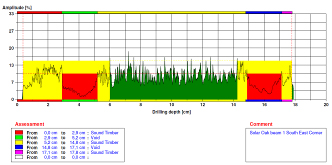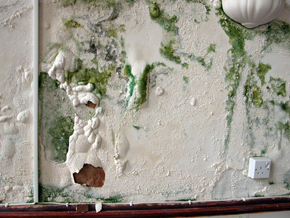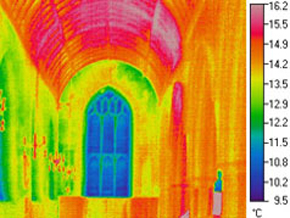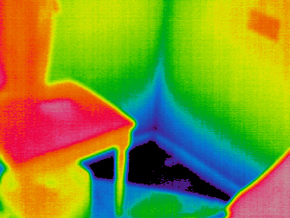Minimally and Non-destructive Survey Techniques
When we undertake our timber and damp surveys we can, where required employ a range of non-destructive testing and analysis techniques.
Micro Drilling
 A micro-drill is used to measure the resistance in timber as a 3mm drill is drilled into a beam, joist or lintol where they are bedded in the walls to identify pockets of decay within the timber which is not visible to the naked eye or other testing techniques. This process allows the condition of embedded timbers to be established without the need for intrusive and damaging removal of masonry. It is particularly useful for investigation oak timber framed buildings suffering from attacks of death watch beetles because the decay caused by these insects is usually significantly worse where the timber is bedded in masonry.
A micro-drill is used to measure the resistance in timber as a 3mm drill is drilled into a beam, joist or lintol where they are bedded in the walls to identify pockets of decay within the timber which is not visible to the naked eye or other testing techniques. This process allows the condition of embedded timbers to be established without the need for intrusive and damaging removal of masonry. It is particularly useful for investigation oak timber framed buildings suffering from attacks of death watch beetles because the decay caused by these insects is usually significantly worse where the timber is bedded in masonry.
 Micro drilling can provide extremely useful information for the structural assessment of buildings. We can provide cross sectional analysis of timber beams, joists, lintols, etc to assist with shear strength calculations in association with our recommendations for the repair and conservation of damaged timber supports. By proving the strength of old timbers we can retain more of the historic building fabric avoiding the need for costly replacement works.
Micro drilling can provide extremely useful information for the structural assessment of buildings. We can provide cross sectional analysis of timber beams, joists, lintols, etc to assist with shear strength calculations in association with our recommendations for the repair and conservation of damaged timber supports. By proving the strength of old timbers we can retain more of the historic building fabric avoiding the need for costly replacement works.
Borescopes
 To avoid lifting floor boards and damaging other areas of historic fabric concealing voids, such timber panelling, we can inspect voids and cavities with a borescope. We are able to check the voids for evidence of fungal and beetle attack and other sources of moisture.
To avoid lifting floor boards and damaging other areas of historic fabric concealing voids, such timber panelling, we can inspect voids and cavities with a borescope. We are able to check the voids for evidence of fungal and beetle attack and other sources of moisture.
Damp Analysis
 We can provide a full damp anaylsis service. A truly accurate assessment of damp can only be made by a laboratory investigation of masonry samples removed from the walls by drilling with a 10mm drill bit. The samples are collected on site in sealed containers, the wet are dry weights are determined to give a weight/weight % moisture content. The samples are then put into a chamber at a constant relative humidity of 70% and allowed to equilibriate so the hygroscopic moisture content and available moisture content values can be calculated.
We can provide a full damp anaylsis service. A truly accurate assessment of damp can only be made by a laboratory investigation of masonry samples removed from the walls by drilling with a 10mm drill bit. The samples are collected on site in sealed containers, the wet are dry weights are determined to give a weight/weight % moisture content. The samples are then put into a chamber at a constant relative humidity of 70% and allowed to equilibriate so the hygroscopic moisture content and available moisture content values can be calculated.
 We can also undertake salt analysis to determine the presence of chlorides and nitrates, both of which are found in ground waters and can suggest the presence of rising damp.
We can also undertake salt analysis to determine the presence of chlorides and nitrates, both of which are found in ground waters and can suggest the presence of rising damp.
There are many potential sources of moisture into the building fabric. A superficial assessment of the internal surface with a damp meter will not differentiate between the sources of damp. Indeed, standard moisture meters must be used with care and experience. Moisture meters do not measure moisture. They measure the electrical conductivity, which can be influenced in masonry but contamination such as salts, which results in artificially high readings.
 By correctly identifying the source of moisture and the severity and location of moisture within the building fabric, advice and recommendations can be made to resolve the damp issues without the use of irreversible damp proofing treatments. In most cases, damp can be designed out with basic building work when the problem has been correctly identified and fully understood.
By correctly identifying the source of moisture and the severity and location of moisture within the building fabric, advice and recommendations can be made to resolve the damp issues without the use of irreversible damp proofing treatments. In most cases, damp can be designed out with basic building work when the problem has been correctly identified and fully understood.
Environmental Monitoring
 Monitoring the internal and external environment and the internal wall surface temperatures can provide very useful information about how the building is being used and whether condensation is occurring. The information obtained from data loggers can demonstrate if condensation is the result of insufficient heating or ventilation or a combination of the both. This has been very useful in tenanted properties where the occupants do not heat or ventilate the problems and then have massive "damp" mould and condensation issues.
Monitoring the internal and external environment and the internal wall surface temperatures can provide very useful information about how the building is being used and whether condensation is occurring. The information obtained from data loggers can demonstrate if condensation is the result of insufficient heating or ventilation or a combination of the both. This has been very useful in tenanted properties where the occupants do not heat or ventilate the problems and then have massive "damp" mould and condensation issues.
Thermal Imaging
 We use high specification 640 x 480 sensor thermal imaging cameras with a wide angle lens. Thermal imaging cameras detect minute surface temperature variations. As damp masonry heats up and slows down at different rates it is possible to detect areas and sources of damp and condensation. Our inspections are carried out using portable equipment and can also detect potential dangerous situations not noticeable to the naked eye, such as hot bearings and hand rails on escalators.
We use high specification 640 x 480 sensor thermal imaging cameras with a wide angle lens. Thermal imaging cameras detect minute surface temperature variations. As damp masonry heats up and slows down at different rates it is possible to detect areas and sources of damp and condensation. Our inspections are carried out using portable equipment and can also detect potential dangerous situations not noticeable to the naked eye, such as hot bearings and hand rails on escalators.
The uses of infa-red thermography are as follows:

- Destructive water damage
- Leaking water pipes
- Cold bridges, cold spots and condensation
- Drying patterns in damp buildings
- Missing or damaged insulation in cavity walls and roofs
- Air leakage tests
- Qualitative assessment of chimney linings







